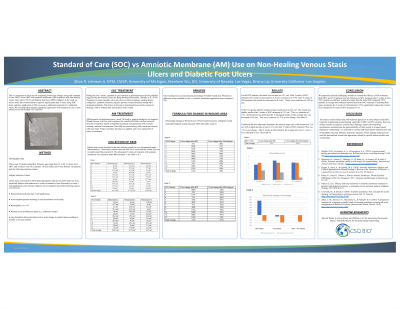Evidence-Based Practice
(EBP-007) Retrospective Study of Amniotic Membrane Use on Non-Healing Venous Stasis Ulcers and Diabetic Foot Ulcers

Methods: Subjects in the study are chosen when their wound failed to improve significantly after 5 weeks using SOC alone, and thus, the application of AM was used as an additional treatment for 5 additional weeks. There were 21 patients identified. Patients’ ages range from 44 to 86. 9 ulcers were DFU, and 12 ulcers were VLU.
Results: In the VLU group, patients’ wound area decreased 1.92% on average with SOC alone, and their wound areas decreased 57.25% on average after SOC with AM. Overall, SOC alone resulted in an average 5% increase in wound area, whereas SOC with AM resulted in an average 50.81% reduction in wound area. Wound size reduction using SOC with AM versus SOC alone is statistically significant (p=0.0001). Comparison between size reduction using SOC with AM in DFU versus VLU patients is statistically insignificant (p=0.17), which means that SOC with AM is equally effective in both DFU and VLU patients
Discussion:
We purposely selected challenging wounds to evaluate the efficacy of AM treatment. Both DFU and VLU patients were all refractory to SOC treatment after 5 weeks. In fact, VLU patients overall have wound size larger than the initial SOC treatment. DFU patients on average have minimal improvement with SOC treatment. Compared to the 5 weeks of SOC treatment with AM, the change in wound size is significant. We concluded that amniotic membrane application with standard of care is more efficacious in non-healing VLU and DFU.
Trademarked Items:
References: Dreifke, M. B., Jayasuriya, A. A., & Jayasuriya, A. C. (2015). Current wound healing procedures and potential care. In Materials Science and Engineering C (Vol. 48).
https://doi.org/10.1016/j.msec.2014.12.068
Elheneidy, H., Omran, E., Halwagy, A., Al-Inany, H., Al-Ansary, M., & Gad, A. (2016). Amniotic membrane can be a valid source for wound healing. International Journal of Women’s Health, 8. https://doi.org/10.2147/IJWH.S96636
Kogan, S., Sood, A., & Granick, M. S. (2018). Amniotic Membrane Adjuncts and Clinical Applications in Wound Healing: A Review of the Literature. In Wounds: a compendium of clinical research and practice (Vol. 30, Issue 6)
Hilmy N., Yusof N., Nather A. Human Amniotic Membrane. World Scientific Publishing Co Pte Ltd.; Singapore: 2017. Anatomy and Histology of Amnion; pp. 87–101.
Irakoze L, et al. Efficacy and time sensitivity of amniotic membrane treatment in patients with diabetic foot ulcers: a systematic review and meta-analysis. Diabetes Therapy. 2017;8(5):967-79
Litwiniuk, M., & Grzela, T. (2014). Amniotic membrane: New concepts for an old dressing. In Wound Repair and Regeneration (Vol. 22, Issue 4). https://doi.org/10.1111/wrr.12188 Zelen, C. M., Serena, T. E., Denoziere, G., & Fetterolf, D. E. (2013). A prospective randomised comparative parallel study of amniotic membrane wound graft in the management of diabetic foot ulcers. International Wound Journal, 10(5). https://doi.org/10.1111/iwj.12097

.png)